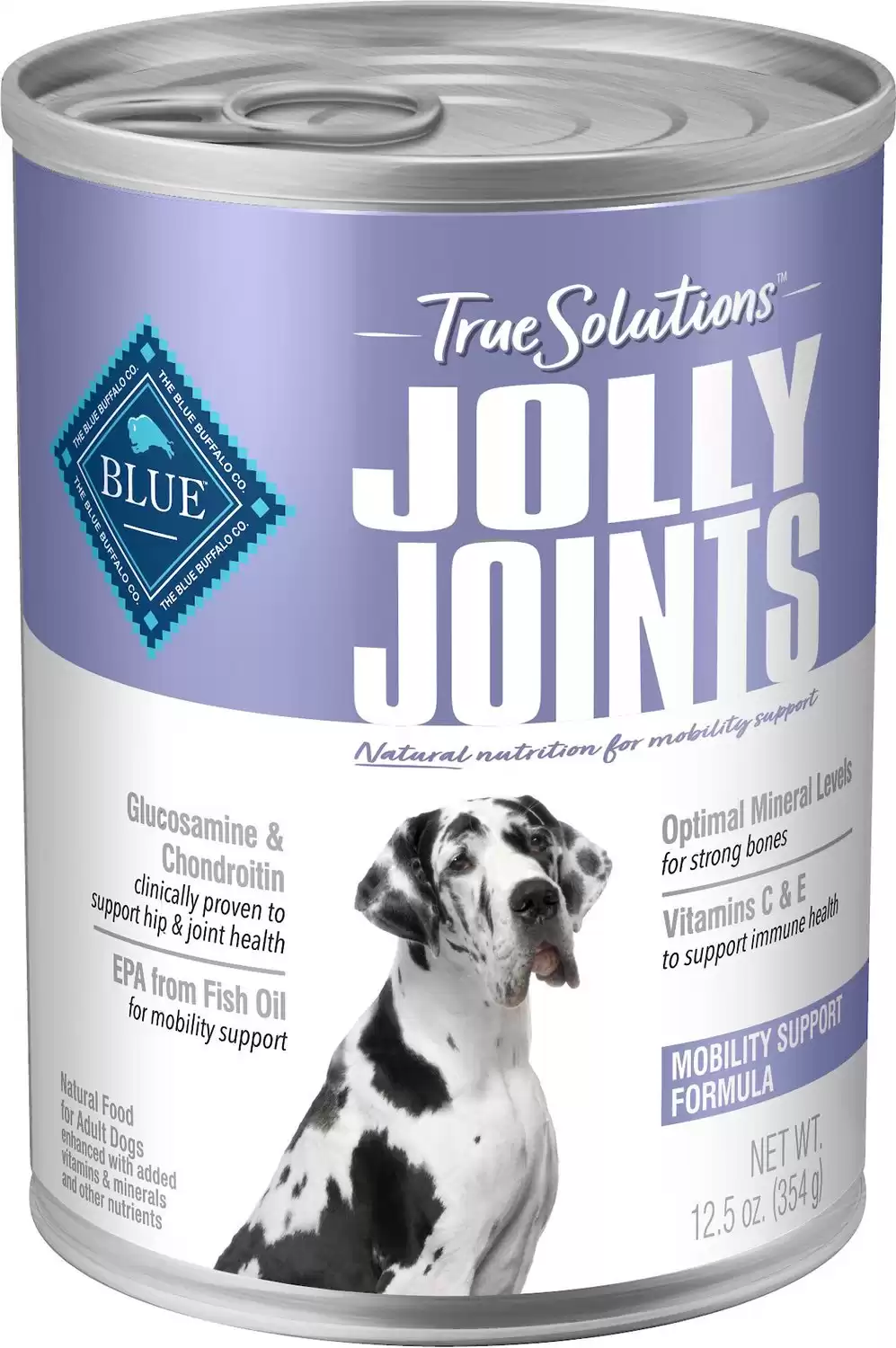Catahoula Leopard
Canis lupus
The state of Louisiana's only native dog breed
Advertisement
Catahoula Leopard Scientific Classification
- Kingdom
- Animalia
- Phylum
- Chordata
- Class
- Mammalia
- Order
- Carnivora
- Family
- Canidae
- Genus
- Canis
- Scientific Name
- Canis lupus
Read our Complete Guide to Classification of Animals.
Catahoula Leopard Conservation Status
Catahoula Leopard Facts
Catahoula Leopard as a Pet:
- General Health
- Energy Level
- Shedability
- Trainability
- Intelligence
- Tendency to Chew
- Size
- Family and kid friendliness
- Yappiness / Barking
- Low
- Separation Anxiety
- High
- Preferred Temperature
- Average climate
- Exercise Needs
- High
- Friendly With Other Dogs
- Moderate
- Pure bred cost to own
- $400-$900
- Dog group
- Herding
- Male weight
- - lbs
- Female weight
- - lbs
This post may contain affiliate links to our partners like Chewy, Amazon, and others. Purchasing through these helps us further the A-Z Animals mission to educate about the world's species.
View all of the Catahoula Leopard images!
The name Catahoula comes from the Choctaw word that means “sacred lake.”
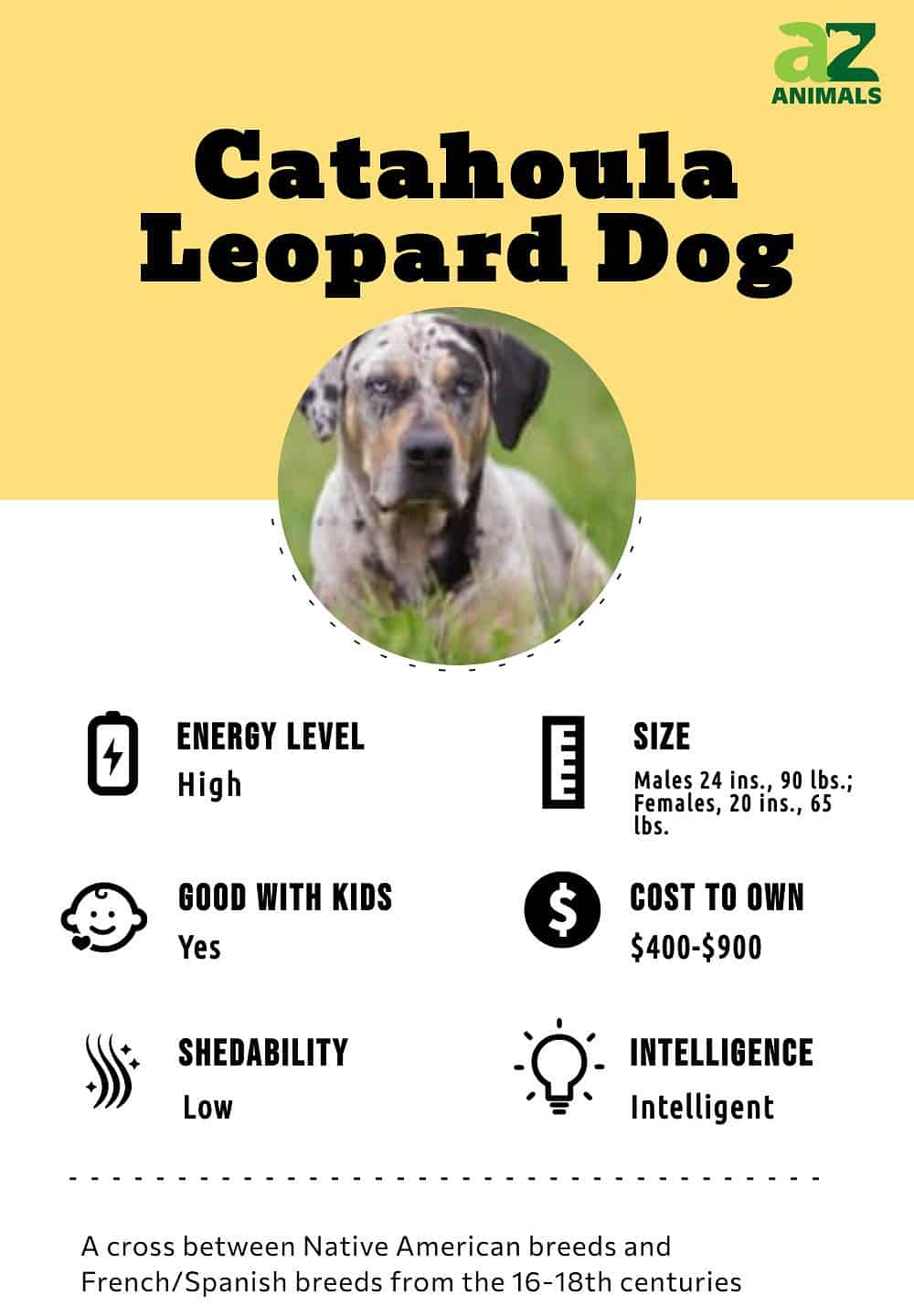
The Catahoula Leopard dog is a versatile working dog native to Louisiana, most commonly used to work stock. It is also known as the Catahoula Cur and the Catahoula Hog Dog. This breed has its origins in crosses between the wolf-like dogs that local Native Americans owned and dogs that Spanish and French settlers brought between the 16th and 18th centuries. It is the only breed of dog to have originated in Louisiana, and thus it was bred to work in swamps and forests.
See all of our expert product reviews.
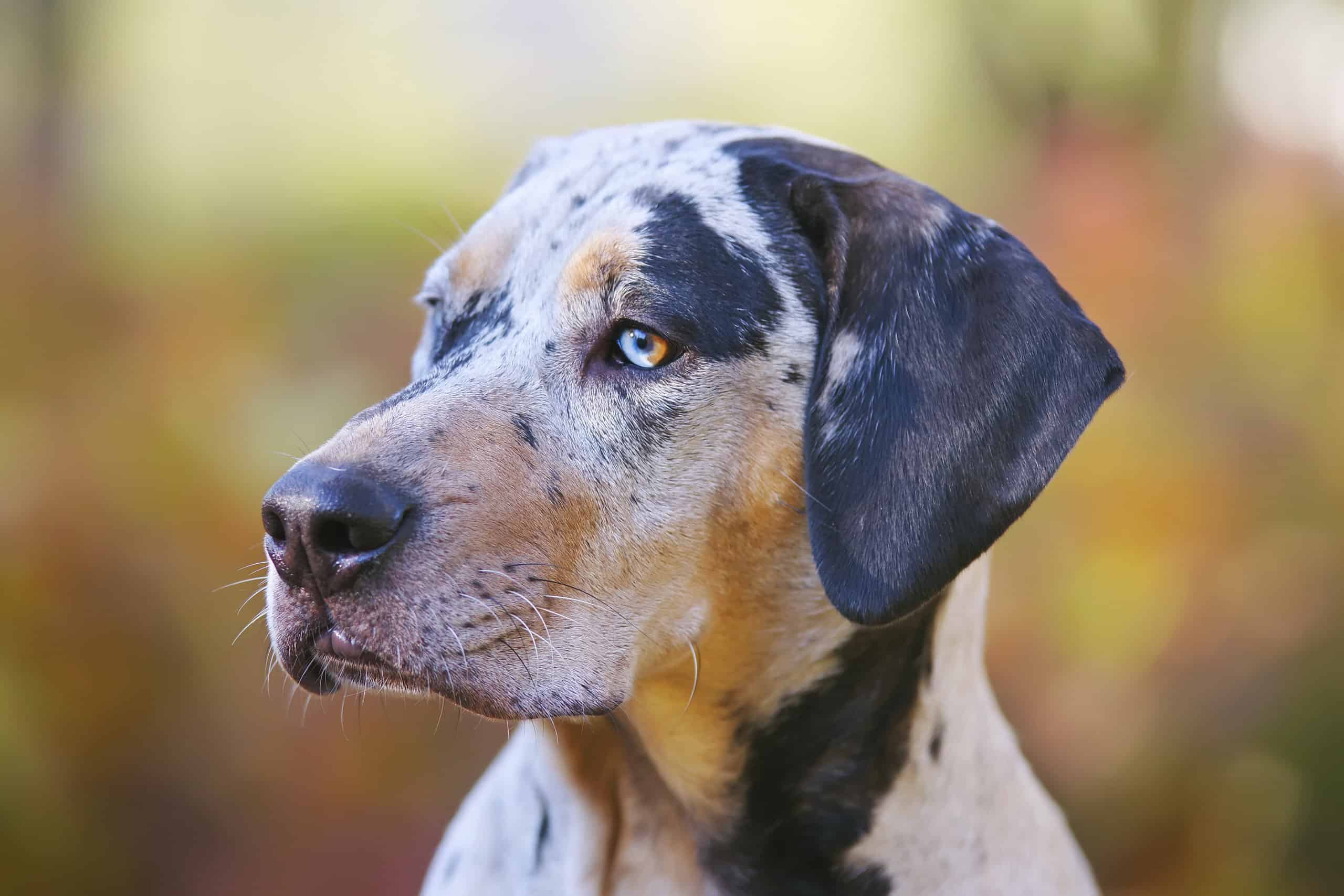
Catahoula
leopard
dogs are adept at herding, hunting, and guarding and are loyal companions.
©Eudyptula/Shutterstock.com
Although initially used to help round up feral cattle and pigs, these dogs have also demonstrated hunting and guarding abilities. Catahoulas are very energetic and eager to please. Strong-willed, but intelligent, the breed is devoted to any task its owner wants it to perform.
Health and Entertainment for your Catahoula Leopard
- Best Dog Food for Dogs With Diarrhea (Senior, Adult, and Puppy) — Reviewed and Ranked
- The Best Wet Food for Senior Dogs
- Victor Senior Healthy Weight Dog Food Review: Recalls, Pros, Cons, and More
- The Best Dog Food for Chihuahuas: Ranked and Reviewed
- Royal Canin Bulldog Dog Food Review: Pros, Cons, Recalls
See all of our expert product reviews.
With their varied history, Catahoulas are one of the most versatile breeds, having stayed true to their early American working roots. Their energetic yet loyal nature helps make them perfect family companions.
3 Pros and Cons of Ownership
| Pros! | Cons! |
|---|---|
| An athletic dog that loves a lot of activity. | Tends to be energetic to the point of rowdiness when young. |
| Smooth-coated and easy to keep groomed. | Chews, digs, and acts destructively when bored. |
| Excellent as a watchdog and protective of your family. | Inclined to chase other animals. |
Appearance
Just as there are genes for eye and hair color, there is a gene that gives the Catahoula Leopard its merle coloring. While this dog can be a solid color, it mostly comes in blue merle, red merle, and brindle. Solid coat Catahoulas will still have small splashes of other colors. These dogs are well-muscled and powerful.
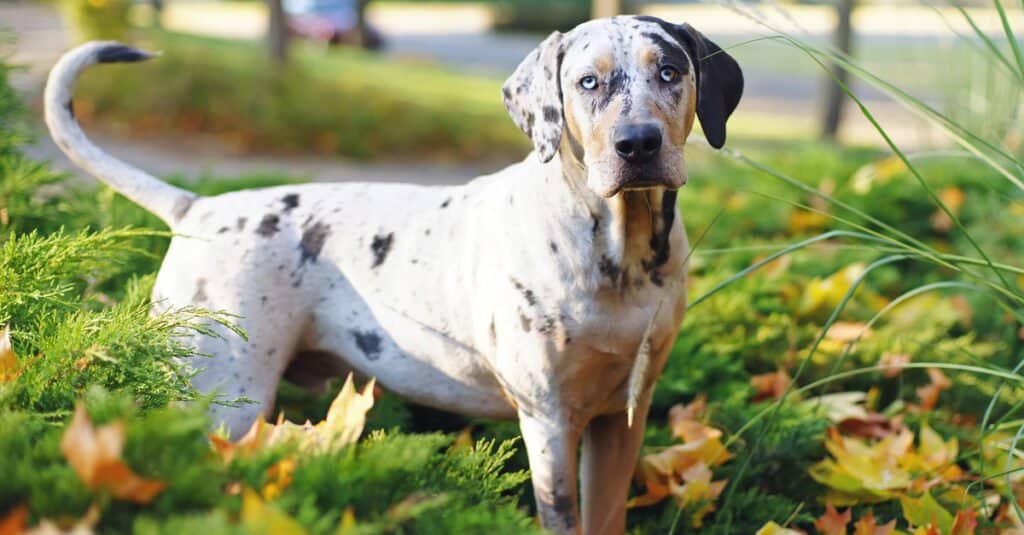
©Eudyptula/Shutterstock.com
Temperament and Behavior
Catahoula Leopards are intelligent, energetic, protective, and loyal dogs. Although these dogs exemplify behavior perfect for their working background, they are adaptable for family life. Catahoula Leopards have a lot of personality and are sure to delight everyone they meet.
These dogs are tough and have a strong work ethic. Although the traits that make these dogs excellent workers go back to their hog and cattle-driving days, they can handle a lot of tasks. Still, a dog is not a true Catahoula Leopard unless it has the instinct to herd by creating a “canine fence” around livestock.
Any behavior issues these dogs have can respond well to training. The dog’s adventurous personality makes it a perfect companion on hiking and other outdoor trips.
Size and Weight
The Catahoula Leopard is a medium to a large-sized dog with a short, smooth coat. The average male height is 24 inches, while the female height averages 20 inches. When males are fully grown, they average 90 lbs, with females averaging 65 lbs. Because of their size that veers somewhat larger, these dogs are physically mature at two years old.
| Height (Male): | 24 inches tall |
| Height (Female): | 20 inches tall |
| Weight (male): | 90 pounds, fully grown |
| Weight (female): | 65 pounds, fully grown |
Common Health Issues
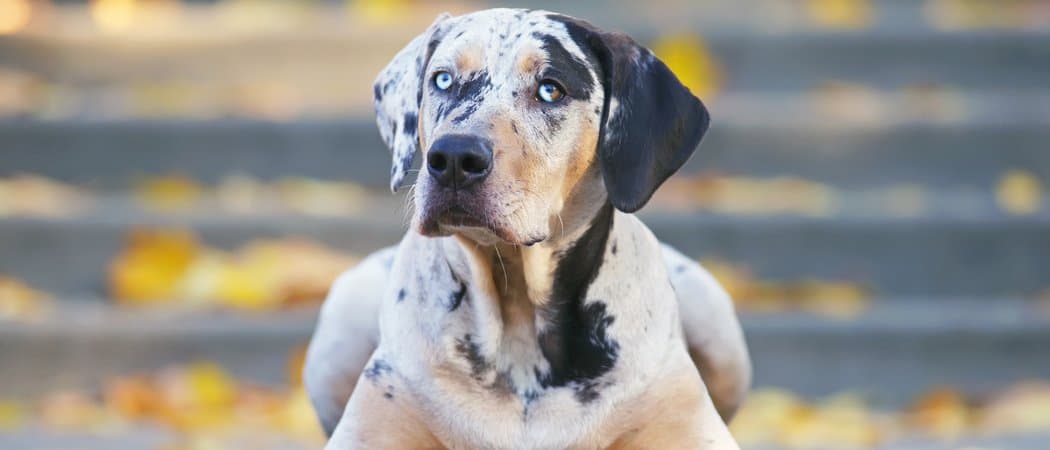
The Catahoula leopard dog is prone deafness, particularly if it has a merle coat and blue eyes.
©Eudyptula/Shutterstock.com
Catahoula Leopards are healthy dogs for the most part but may have a few health issues. Hip Dysplasia, common in many larger breeds, is a condition that may affect these dogs later in their lifespan. Cataoulas may also experience deafness, with dogs that have a merle coat and blue eyes being more susceptible. These dogs may develop eye issues that are associated with certain lines bred to preserve the most popular colors. Abnormal pupil dilation, tunnel vision, and difficulty opening the eyes may occur. Catahoula Leopards may develop certain cancers as older dogs. Skin cancer is one of the more common types of cancer, although likely treatable if caught early.
In short, the health issues you will have to think about the most with this breed include:
- Hip Dysplasia
- Deafness
- Eye problems
- Cancer
Care
Pet owners taking care of Catahoula Leopards, from puppies through adulthood, need to consider a diverse range of factors, regardless of whether you’re dealing with the speed of these dogs at play or whether to get a rescue dog.
Best Dog Food
Catahoula Leopards need a high-quality diet, from the time they are puppies, to thrive. When you are buying dog food for your pet, here are some important things to consider:
Catahoula Leopard puppy food: Hip dysplasia is a legitimate concern for Cataholas because of their size, so the right food as puppies is vital. High-quality puppy food that includes calcium among its ingredients is ideal, whether wet or dry. The meat content should be lean, such as fish or poultry. These dogs should remain primarily on puppy food until two years of age, then gradually transitioned to adult food.
Catahoula Leopard adult dog food: Adult Catahoulas should eat food designed for large, active dogs that contains nutrients protecting bone and joint health. One of the things that you may want to look for is a food that contains glucosamine, or a supplement containing this nutrient.
Taking this breed’s vulnerable joints into account, A-Z Animals believes the best dog food for Catahoula Leopards is Blue Buffalo True Solutions Jolly Joints Natural Mobility Support Adult Dry Dog Food and Wet Dog Food.
This targeted nutrition dog food is perfect for Catahoula Leopards and other hip dysplasia-prone dogs, with a balance of naturally occurring glucosamine from real chicken. The taurine and vitamin A work together to protect their eye health and vision also. This recipe is full of amino acids for head-to-toe wellness.
Try out Blue Buffalo Jolly Joints Natural Mobility Support Dog Food, available on Chewy and Amazon.
- Glucosamine and chondroitin support healthy hips and joints, EPA from fish oil encourages healthy mobility and minerals promote strong bones.
- Crafted with natural ingredients and enhanced with vitamins, minerals and other nutrients.
- Made with real chicken as the very first ingredient, followed by fruits and veggies to naturally support mobility.
- Wheat-free recipe made without chicken (or poultry) by-product meals or other common food allergens like corn, wheat or soy.
- 100% free from artificial flavors and preservatives.
Maintenance And Grooming

Catahoula leopards need stimulation from activities such as hiking and swimming.
©otsphoto/Shutterstock.com
Since it has a short coat, the Catahoula Leopard has minimal grooming requirements. Weekly brushing is sufficient outside of the regular shedding season that occurs in early spring. Using a dog brush with stiff bristles, followed up by polishing with a grooming mitt, will keep your dog’s coat looking perfect. Catahoulas are not as susceptible to skin problems as some other breeds, but they may experience allergic dermatitis due to flea bites or other stimuli. Because Catahoula Dogs shed very little, their coats are largely hassle-free.
Training
Catahoula Leopards are somewhat challenging to train in comparison to other breeds because of their independence. Socialization makes all the difference in ensuring that training is effective. Training sessions need to be short to reduce the risk of the dog getting bored. Owners need to remember that these dogs reach full maturity at two.
Exercise
Catahoula Leopards have a high energy level and can easily run at a high speed. These dogs need to live in a house that has a large enough yard for regular exercise. Catahoulas are not suitable for apartments or other small spaces; they often becoming destructive when bored. These dogs require one or more walks a day or vigorous play in the yard for at least an hour daily. Fetch with balls or frisbees is perfect for this breed. Hiking and swimming are also excellent ways of keeping this dog stimulated.
Puppies
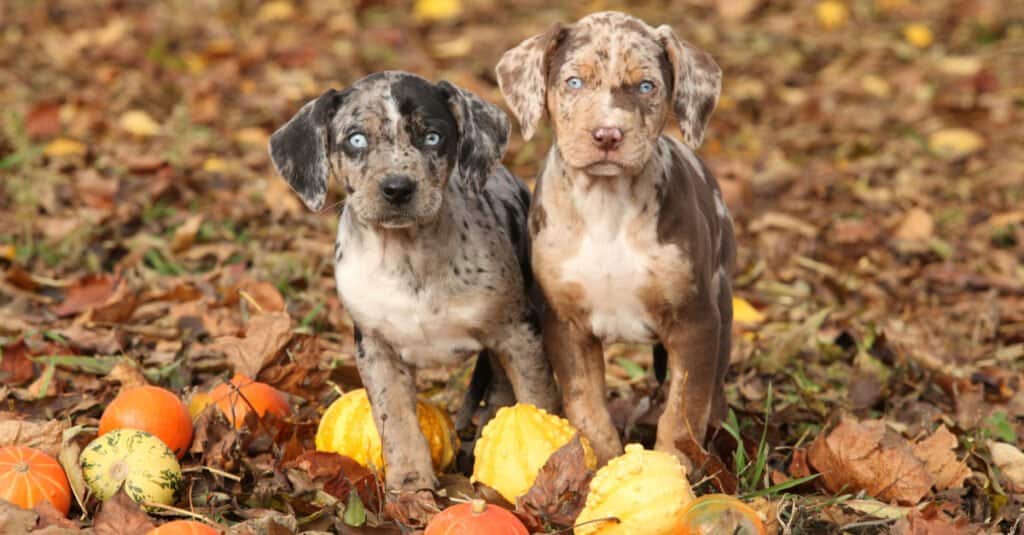
©Zuzule/Shutterstock.com
Catahoula puppies require early socialization, regardless of whether they come from a breeder or a rescue. The earlier these dogs are socialized, the better they will get along with other dogs. Training at an earlier age helps Catahoula Dogs know what you expect of them.
Children
Catahoula Leopards have a very affectionate temperament with children. Although they can keep up with the demands of kids very easily, their large size makes them less ideal for smaller children. Older children and teens will do best with these dogs.
Similar Dogs
Dogs that are similar to the Catahoula Leopard in colors are the Australian Shepherd and Australian Cattle Dog, while a similar breed in personality is the American Bulldog:
- Australian Shepherd – Some of the traits that Australian Shepherds share with Catahoula Leopards include common colors, high intelligence, speed, and trainability. These dogs have a long coat that requires more grooming and maintenance.
- Australian Cattle Dog – Although somewhat smaller in size, Australian Cattle Dogs have patterns that include merle colors, a lifespan that matches or well exceeds that of a Catahoula Leopard, and a relatively low-maintenance coat, although Cattle Dogs are double-coated.
- American Bulldog – American Bulldogs share a strong working history, minimal shedding, and a family-friendly temperament with Catahoula Leopards.
Famous
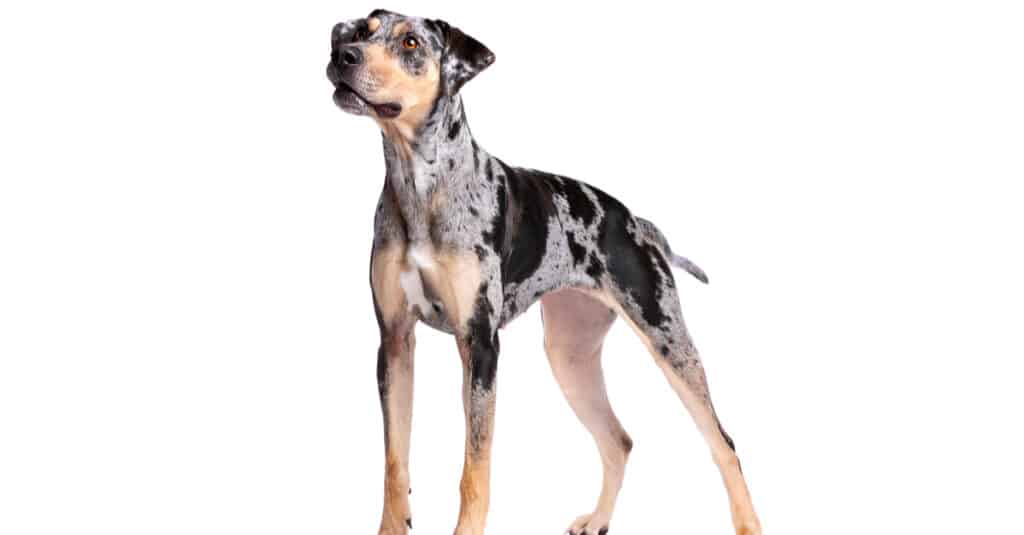
A Catahoula leopard has been owned by Jim Bowie, Teddy Roosevelt, and Earl K. Long.
©Erik Lam/Shutterstock.com
Although not as well-known a breed as some others, Catahoulas occupy enough of a place in Louisiana culture that there have been a few famous dogs of this breed known in history:
- Rezin and Jim Bowie (of Bowie knife and Alamo fame) lived in Catahoula Parish in their youth and had a pair of these dogs. These dogs slept at the brothers’ feet, demonstrating that they were loyal!
- Theodore Roosevelt owned one of these dogs during the early 1900s. The Catahoula was a favorite hunting companion for this active sportsman!
- Louisiana Governor Earl K. Long was noted as a breed enthusiast. This interest was the inspiration behind the annual Uncle Earl’s Hog Dog Trials!
- Centenary College of Louisiana selected the Catahoula Leopard as its mascot in 2007!
Popular Names for Catahoula Leopard
Popular names for Catahoula Leopards are:
- Beau
- Bella
- Bleau
- Abby
- Leo
- Remy
- Lola
- Scout
- Willow
- Roux
Catahoula Leopard FAQs (Frequently Asked Questions)
Is Catahoula Leopard good with kids?
Catahoulas are generally good with kids, but caution is necessary around very young children because of the Catahoula’s size.
How long does Catahoula Leopard live?
Catahoula Leopards have a lifespan that averages 12 to 14 years.
Are Catahoulas good family dogs?
Catahoulas are good family dogs that do well with active families, although they are best for older children.
Do Catahoula Leopard dogs bark a lot?
Catahoula Leopards usually only bark to alert their owners.
Are Catahoula Leopard Dogs rare?
The Catahoula Leopard Dog is a relatively rare breed outside of the American South.
What breeds make up a Catahoula Leopard Dog?
Wolfdogs were raised by the Choctaw tribe, along with Bloodhounds, Greyhounds, and Mastiffs introduced by Europeans.
How much is a Catahoula Leopard Dog?
A Catahoula from a breeder will cost $600 to $900, and a dog from a rescue might cost $100 to $300.
How big do Catahoula Leopard dogs get?
Catahoulas reach 20 to 24″ in height and 60 to 95 lbs in weight.
Are Catahoula Leopard dogs easy to train?
Catahoulas are easy to train when they have been socialized and owners are consistent in their training.
What are the key differences between a Catahoula Leopard Dog and an Australian Cattle Dog?
The key differences between a Catahoula Leopard Dog and an Australian Cattle Dog are size, coat, temperament, health issues, and training.
What are the key differences between Catahoula Leopard Dogs and American Leopard Hounds?
The key differences between Catahoula Leopard Dogs and American Leopard Hounds are appearance, temperament, training, and lifespan.
What are the key differences between Catahoula Leopard Dogs and coyotes?
The key differences between Catahoula Leopard Dogs and coyotes are appearance, diet, health issues, and lifespan.
What are the key differences between Catahoula Leopard Dogs and German Shepherds?
The key differences between Catahoula Leopard Dogs and German Shepherds are appearance, coat, temperament, health issues, exercise, and training.
What are the key differences between Catahoula Leopard Dogs and Border Collies?
The key differences between Catahoula Leopard Dogs and Border Collies are appearance, coat, temperament, health issues, exercise, and training.
What are the key differences between Catahoula Leopard Dogs and Blue Heelers?
The key differences between Catahoula Leopard Dogs and Blue Heelers are appearance, coat, temperament, health issues, exercise, and training.
What are the key differences between Catahoula Leopard Dogs and Belgian Malinois?
The key differences between Catahoula Leopard Dogs and Belgian Malinois are origin, appearance, lifespan, temperament, trainability, and grooming.
What are the key differences between Catahoula Leopard Dogs and Australian Shepherds?
The key differences between Catahoula Leopard Dogs and Australian Shepherds are origin, appearance, lifespan, temperament, trainability, and grooming.
What are the key differences between Catahoula Leopard Dogs and Great Danes?
The key differences between Catahoula Leopard Dogs and Great Danes are origin, appearance, lifespan, temperament, trainability, and grooming.
Thank you for reading! Have some feedback for us? Contact the AZ Animals editorial team.
Sources
- American Kennel Club / Accessed September 25, 2021
- Fair Mate Catahoulas / Accessed September 25, 2021
- Pet Assure / Accessed September 25, 2021
- (1970) Aubrey Medical Animal Center / Accessed September 25, 2021
- Chewy / Accessed September 25, 2021
- A-Z Animals / Accessed September 25, 2021
- waybackmachine / Accessed September 25, 2021
- Wikipedia / Accessed September 25, 2021






